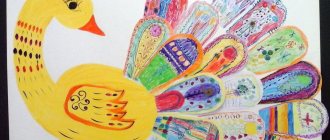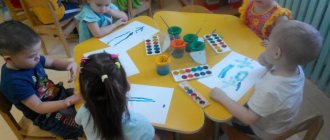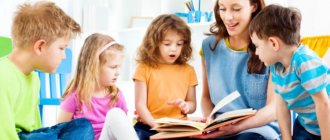Summary of the drawing lesson “How birds return from distant lands”
Milausha Gallyamova
Summary of the drawing lesson “How birds return from distant lands”
How birds return from distant lands
(examination of paintings by A.K. Savrasov
"The Rooks Have Arrived"
and A. A. Rylov
“Fresh Wind”
,
drawing )
Goals. Arouse in children interest in the topic of the image, an emotional response to it, a desire to reflect their impressions associated with poetic works and observations of the arrival of birds . birds returning from the south in a landscape , using the means of representation: drawing, color, composition, a low horizon line, arranging the format of a sheet of paper depending on the invented plot. Develop the ability to give emotional and aesthetic assessments and express detailed judgments.
Materials. Reproductions of art paintings by A. A. Rylov “Fresh Wind”
, A.K. Savrasova
“The Rooks Have Arrived”
, watercolor paints, brushes, palettes, album sheets of paper.
Schemes depicting birds in flight . Recording of the musical play “March.
Song of the Lark" from the cycle
"Seasons"
by P. I. Tchaikovsky.
Preparatory work. Observing spring changes in nature, the behavior of migratory and wintering birds . Reading works of fiction on the topic. Conversation about wintering and migratory birds . Looking at illustrations , drawings depicting different birds : rooks, starlings, swallows, larks, cranes, geese, swans, etc. Reading poems about spring, singing songs.
Class.
Educator. Children, you and I watched how all nature rejoiced in spring, waking up from sleep - trees, flowers, and people. But today we will talk about how birds . Remember, we saw how sparrows, pigeons, and crows bask in the warm rays of the sun, how they scurry around, bathe in puddles, chirp and croak loudly and joyfully.
The sun rises over the earth
Every day it gets higher
And all day long they circle and coo
Pigeons on the roof.
But spring is also a joy for birds that return from warm countries . Which birds returned first ? Yes, these are rooks. People say: “A rook in the yard means spring on the mountain.”
,
.
” Do you remember how we watched in the birch grove how the rooks rejoiced when they returned to their nests? Look at the painting “The Rooks Have Arrived”
by Alexei
Konstantinovich Savrasov . We have already looked at it. Tell me, what are these rooks doing? Where do they build their nests? What place did the artist paint ? What kind of weather is shown here? (Children's answers)
Not only rooks returned home, but also very interesting birds , they are called the first singers of spring. These birds imitate the voices of other birds and animals . Who is this? Yes, starlings. People say: “I saw a starling - it’s spring on the porch.”
.
We saw them too and even made a birdhouse for them. birds are also flying home . Yesterday we watched the cranes fly. How did they fly? A triangle, they say, “a jamb”
;
some birds fly in a caravan (one after another, others in flocks. Look at A. A. Rylov’s painting “Fresh Wind”
. Tell us, what kind of
birds are they flying ? How do they fly? What are they flying over? Have you noticed that the artist I painted them from a very close distance, they turned out large. What is the horizon line here? Why do you think the artist built the picture this way? (Children’s answers.)
Progress of the lesson:
Educator: Guys, listen to the poem:
Spring has arrived in the snow,
Calling from all over
Geese, swifts and storks,
Cuckoos and starlings .
What time of year is the poem talking about? (Spring)
.
What is the most important sign of spring? Birds come to us in spring )
.
Where do they fly from? (From warm countries)
.
What are the names of birds that fly to warmer regions for the winter and fly back in the spring? ( Migratory )
.
What migratory birds do you know ? (Rook, starling , swallow, cuckoo, nightingale)
.
Guys, pay attention to the screen.
Educator: Guys, what kind of bird ? ( Starling )
That's right,
starling . Birds delight us not only with their appearance and the wonderful colors of their plumage , but also with their songs.
In the last lesson we drew a rook , and today I invite you to draw a starling .
Look at the sequence in which we will draw the starling .
Let’s before you start work. Finger gymnastics “ The birds are flying in ”
With the coming of spring,
The birds are coming.
We spread the fingers of both hands, connect the thumbs, and wave the rest like wings.
The starlings are returning ,
And we connect the rooks near the puddle-Palms together in a cup.
The cranes are flying in a hurry, - We spread the fingers of both hands, connect the thumbs, and wave the rest like wings.
And the robin and thrush,
Educator: Well done! Now, get to work.
These are the wonderful starlings we got !
Lesson notes for the senior group “Migratory Birds” Purpose. Formation of elementary ideas in children about migratory birds through active forms and methods of children’s activities. Tasks. Priority.
Summary of an integrated lesson on speech development in the senior group “Wintering and migratory birds” Synopsis of an integrated lesson on speech development in the senior group on the topic: “Wintering and migratory birds”. Goal: clarify and expand.
Summary of educational activities for the development of speech in the senior group of the compensatory focus "Migratory birds" MUNICIPAL BUDGETARY PRESCHOOL EDUCATIONAL INSTITUTION KINDERGARTEN No. 29, AZOV Abstract of educational activities for the development of speech in the senior group.
Summary of OOD on drawing “Migratory birds are flying” with children 6–7 years old Drawing “Migratory birds are flying” Integration of educational areas: “Artistic and aesthetic development”, “Speech development”, “Cognitive.
Summary of a lesson on cognitive development in the senior group “Migratory Birds” Synopsis on the topic: “Birds” Purpose: to form the ideas of senior preschool children about migratory birds. Tasks: 1) Clarify.
Lesson summary for children of the senior group “Birds of Migratory” (by showing a collection of postage stamps) Lesson summary Purpose: To summarize and systematize children’s knowledge about migratory birds and life.
Summary of a lesson on the surrounding world in the senior group "Migratory Birds" Summary of a lesson on the surrounding world in the senior group "Migratory Birds" OBJECTIVES Educational: · Summarize children's knowledge about migratory birds.
Summary of a lesson on speech development in the preparatory group "Birds of Migratory" Summary of educational activities for the development of speech in the preparatory group "Birds of Migratory" Age of children: 6-7 years old Goals: improving grammatical structure.
Summary of a lesson in the preparatory group “Migratory Birds” Migratory birds, summary of a lesson on familiarization with nature Summary of a lesson on familiarization with nature in the senior group, topic: “Migratory.
Source
Summary of a drawing lesson for children of the younger group on the topic “Birds of Migratory”
Goal: Improve knowledge about migratory birds, learn to draw a starling, conveying characteristic features (color, shape, wings, tail).
1. Continue to introduce children to migratory birds.
2. To provide knowledge about adaptation to seasonal changes in nature.
3. Activate and enrich children’s vocabulary on the topic “Birds of Migratory”
4. Strengthen your ability to draw a bird, start with the shape of the head and body.
5. Learn to mix paints to find a new color (white + black = gray).
Material: pictures depicting migratory birds; drawing sheets, gouache, brushes, napkins.
Techniques and techniques that will be used in class
Visual activity has a beneficial effect on the development of the child’s creative abilities, fine motor skills, imagination and fantasy, artistic and spatial thinking, sensory perception and intellectual abilities of the child, and contributes to the formation of an aesthetic perception of the world. In drawing classes, older preschoolers are taught the skills of artistic representation of the surrounding reality, methods of depicting an object with the transfer of simple movements, characteristic features of shape, color and details, and the proportional relationship of parts.
Types of drawing on the theme “Birds”:
Complex large compositions, which consist of various objects and figures, are usually created collectively; children together compose a plot picture on whatman paper, drawing or gluing the silhouettes they have prepared, simultaneously developing spatial thinking abilities, as well as mutual understanding and camaraderie. It is important to pay close attention to the problem of teaching children to understand and follow the correct sequence of work to create a plot composition or collage. The teacher should explain that first you need to prepare a background drawing, painting the entire space of whatman paper, then draw background objects (trees, sun, clouds, flowers, etc.) and only then draw or place previously prepared and cut out silhouettes of birds.
Photo gallery: collective works
Drawing techniques
Classic techniques:
Photo gallery: children's individual works in classical techniques
Non-traditional techniques:




